I've fallen in love with Albania. Here is one reason why:
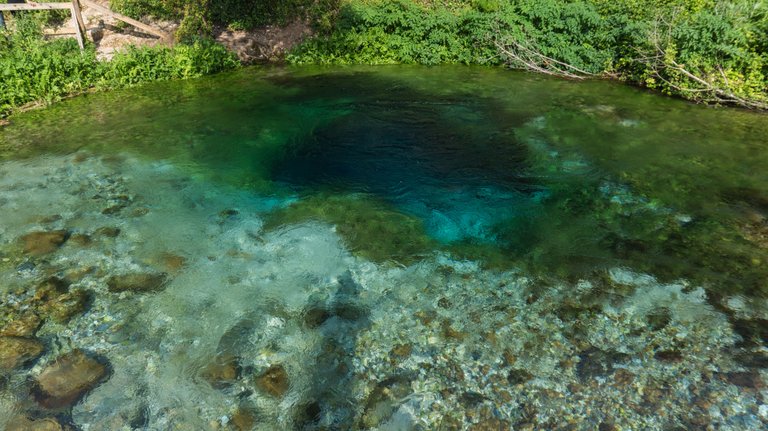
That is a spring known as the Blue Eye, or Syri i kaltër in the Albanian language. But before I go into more detail about that, let's talk some more about Albania first (more beautiful pictures of the Blue Eye coming if you stay with me for a minute, I promise!). I'm guessing Albania probably isn't on your radar as a place to visit. It certainly wasn't for me before this year. Now I've been there twice in two months.
A flag drenched in blood
About the only thing I could've told you about Albania this time last year was that their flag had a rather intense-looking, double-headed black eagle laid atop a solid red background - a symbol that I've always found a bit intimidating since my nerdy schoolboy days when I was quite fond of browsing the colorful flag pages of my World Almanac and Book of Facts, which I collected for a number of years. Anyways, here is what it looks like:
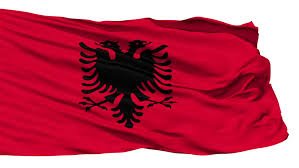
Does this look like a welcoming symbol to you?
I had to inquire about the meaning of this striking emblem. I assumed perhaps it had something to do with being a part of the communist Soviet Bloc, but that's actually not the case. A local explained to me that the two heads on the eagle stand for the unity of the northern and southern Albanian tribes, so that's actually quite nice. The red, on the other hand, represents the struggle for freedom that Albania has endured over the centuries. So it's essentially blood, but serves as a noble reminder of the country's history.
If you're like me and found this a bit threatening at first, don't be deterred. After all, you can't judge a country by it's flag, right?
A 5-minute recent history of Albania
Skip to bottom if you just want pictures (and to upvote!). Read if you want to learn something.
I'm no professor of history, but I like to learn a little bit of background about the places I visit to understand them better, especially unique places like Albania that maybe aren't as well known. So here's a quick timeline of some significant recent happenings that help explain the current state of Albania:
1 Sept. 1928 - Albania becomes a kingdom, President Ahmed Zogu becomes King Zog I.
1938 - King Zog opens Albania's borders to Jews fleeing Nazi Germany.
7 April 1939 - Italy invades Albania and captures the country within 3 days. King Zog flees along with Crown Prince Leka, born in Albania just days before the invasion.
8 Nov. 1941 - Albanian Communist Party formed as one of the primary National Liberation Movement resistance groups.
29 Nov. 1944 - National Liberation movement liberates Albania (only occupied country to liberate itself). Enver Hoxha subsequently becomes prime minister of the provisional government. Pro-Western supporters begin to be purged as the Communists gain power.
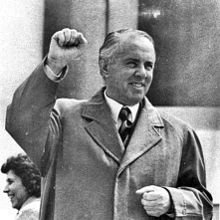
Enver Hoxha
1945 - King Zog attempts to reclaim the throne. He is barred from the country and formally deposed in 1946.
Jan. 1945 - The Albanian region of Kosovo is ceded to Yugoslavia as a part of a treaty. Yugoslavia thereafter becomes the first country to recognize the new government of Albania.
Dec. 1945 - Albania holds "democratic" elections, where the only party on the ticket is the Communist-dominated Democratic Front. Hoxha remains prime minister. Relations with the West begin to deteriorate because free elections were not permitted. Albania restricts movement of U.S. and British personnel in the country, asserting that they are instigating anti-Communist activity.
Jan. 1946 - Newly elected People's Assembly convenes and declares Albania a "people's republic".
1946 - Stalinist-style economic planning model established.
1947-48 - Relations with Yugoslavia deteriorate.
Sept. 1948 - Soviet Union steps in to provide aid to Albania to compensate for loss of support from Yugoslavia. Relations with Yugoslavia continue to degrade until diplomatic contact is terminated in 1950.
Feb. 1949 - Albania gains membership into the Soviet Eastern Bloc.
23 Nov. 1949 - Diplomatic relations with China established.
1950, 1952 - U.S.-trained refugees and emigrants attempt to infiltrate Albania with the goal of restoring King Zog to power. Details of the plan are leaked by a British double agent working for Moscow. All infiltrators are killed or captured, and the mission is a failure.
1952 - Albania responds to a wave of anti-Communist activity by instituting an extreme penal code for anyone over 11 found guilty of conspiring against the state or economic sabotage. Political executions under the Communist regime were somewhere from 5,000 - 25,000 in all.
1950s - Warm relations with Moscow gradually cool. Following Stalin's death in 1953, concerns grow over Khrushchev's rhetoric of re-establishing relations with Yugoslavia, causing Albania to fear an attempted takeover by the hated neighbors to the north. By 1958, Albania begins siding with China on matters of disagreement between the Communist superpowers.
1961 - Following more and more open support of China and opposition to Soviet policies, Moscow begins cutting promised grain deliveries to Albania. Soviet-Albanian relations eventually cease. Albania remains the only Communist European country allied with China. No longer supported by the Soviet Union, and with inferior support from China, the Albanian economy declines.
1964 - Hoxha and the Albanian government hail the fall of Khrushchev from power in the Soviet Union, but relations with the new Soviet regime do not improve, and Albania remains diplomatically separated from Moscow.
1967 - Hoxha begins building dome-shaped bunkers, ostensibly for the purpose of defending Albania from foreign invasion (Yugoslavia being one of the "threats" that the regime insisted were ready to attack at any moment). By Hoxha's death in 1985, over 170,000 are constructed (a lot of sources say 750,000, but I think this is overstated). Construction of the bunkers diverts a large amount of resources away from other needs, like housing, which was constantly in short supply, as well as placing an overall burden on the economy.
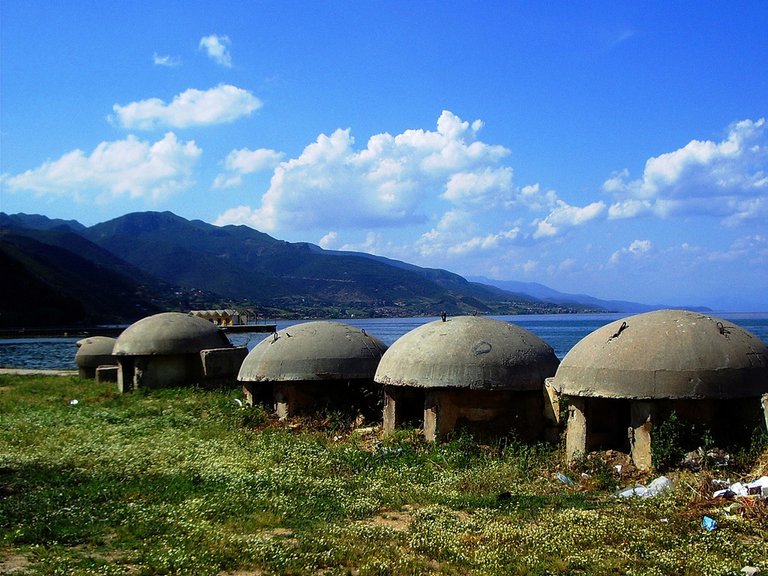
Example of bunkers
1967 - As a part of Hoxha's Cultural and Ideological Revolution, all religion is banned, making Albania the world's first atheist country. Religious groups throughout the country are forcibly required to cease practicing their faith.
1970-1978 - Relations cool with China, culminating in the Chinese ending all assistance programs for Albania in 1978.
1980 - Hoxha chooses Ramiz Alia to succeed him.
1983 - In poor health, Hoxha relinquishes his duties to Alia.
11 Apr. 1985 - Hoxha dies.
1989 - Alia expands reforms to the government as Communist regimes throughout eastern Europe are falling.
11 Dec. 1990 - under enormous pressure from students and workers, Alia announces that opposing political parties may form, and open elections will be held the following spring.
31 Mar. 1991 - In the first free elections held in decades, Alia's party is victorious, but an ensuing strike weakens their power.
22 Mar. 1992 - The Democratic Party defeats the Communist Party in a general election, marking the end of the Communist regime. The new government struggles to deliver on its promises, leading to disappointment and frustration amongst the populace.
June 1996 - The Democratic Party manipulates the results of an election in an attempt to win an outright majority.
1997 - The government falls due to widespread corruption and failure of pyramid schemes, leading to chaos and rebellion throughout the country. Ironically, a few of Hoxha's bunkers are used for the first time during an armed conflict.
22 November 1998 - A constitution is ratified, finally establishing a democratic system of government based upon the rule of law and guaranteeing basic human rights.
Most of this information was gleaned from Wikipedia
So that's post-WWII Albania in a nutshell. I suppose I could sum it up by saying that for nearly 50 years, the country suffered through a xenophobic, oppressive regime that forcibly exerted its power at times and went from Soviet alliance to Chinese to complete isolationism (in case you didn't want to read the history). I hope I didn't get too carried away, but I'd be willing to bet most of you know more about Albania from this post than you did before.
The other purpose of going through the history was to understand why Albania is the way it is today. That is, rather poor and underdeveloped. It feels like it left the rest of the world behind 50 years ago and is just now trying to catch up. I had no idea such a place existed in Europe. I mean, I knew eastern Europe was far different than the west, but I'm pretty sure Albania is lagging behind even some of it's neighbors that maintained a part of either Yugoslavia or the Soviet Union for longer than Albania did.
Interesting Side Story
This may only be interesting to me, but upon talking to my dad about the trip to Saranda, he informed me that he ended up in Dubrovnik, Croatia (then a part of Yugoslavia) as a part of a weeks long Euro backpacking trip he did with a buddy when he was in college, which had begun in London. I pin this as somewhere around 1969. I'm not sure how I missed these stories growing up, but apparently the thought of visiting Albania came up during the trip and was deemed too unsafe to attempt. After having studied Albania's history through that period for this article, I can definitely understand that sentiment but wonder what it was really like for visitors at that time, particularly from the West. Were they permitted? Welcomed? Searched? Allowed to leave when they wanted?
Given Hoxha's policies, I wouldn't be surprised to learn that it was not a very visitor-friendly place, and perhaps it was best that my dad and his friend didn't attempt it. Would really love to hear a story about a Westerner visiting Albania during that era, though.
Back to the Blue Eye
If you're still with me, thank you. Here are some pictures I promised:
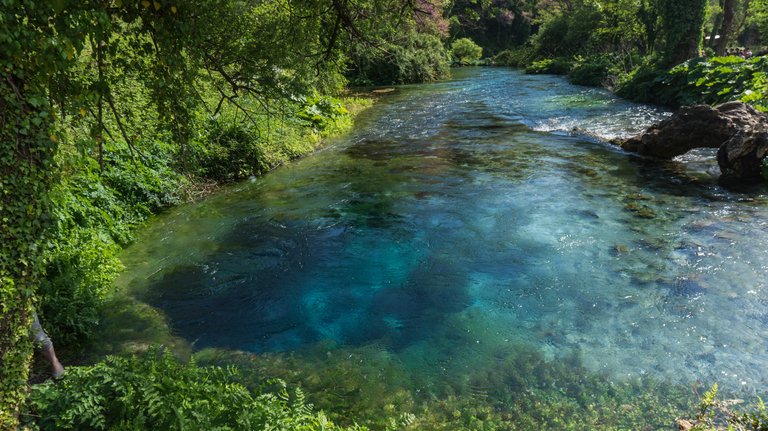
I have never encountered this hue of blue in nature before, certainly not outside of the sea anyways.

We met some fun folks from Florida during our trip.
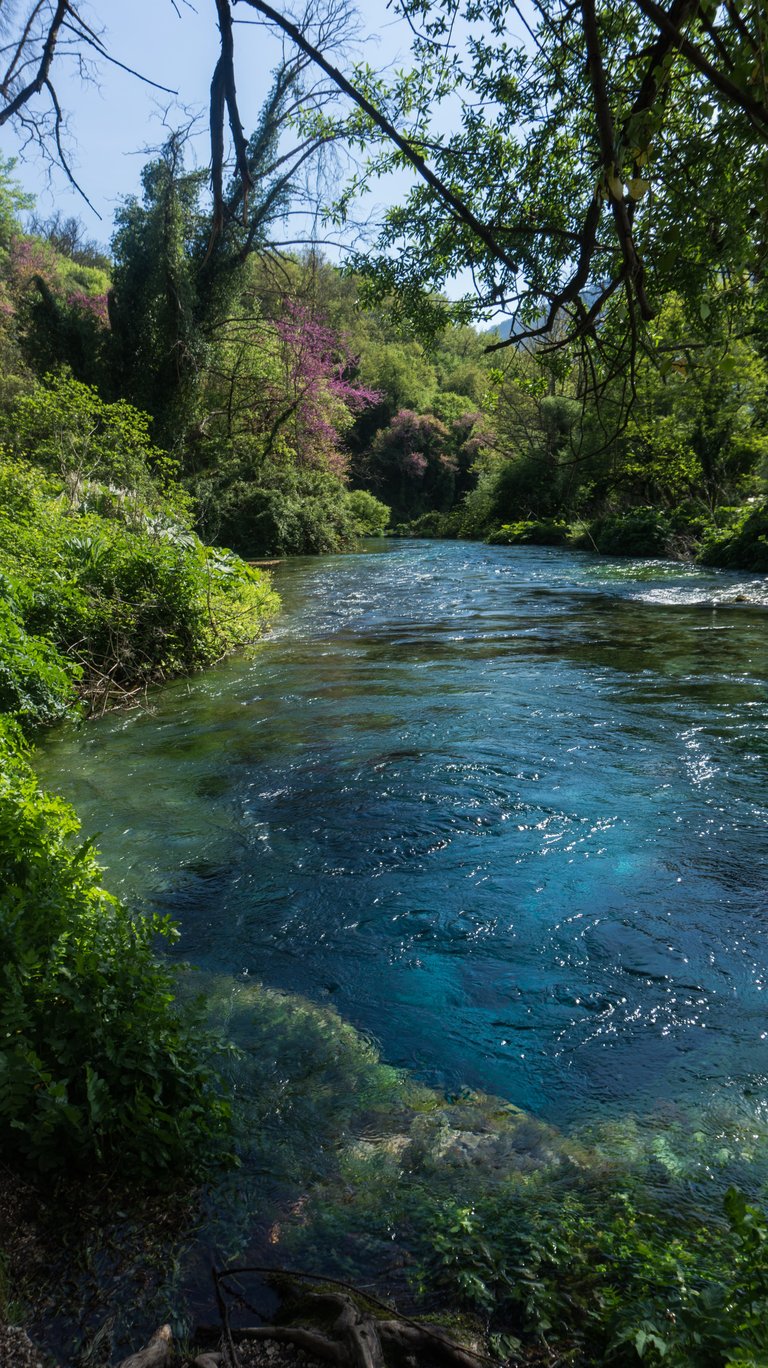
Wish I'd brought some swimming attire, but the water was just a chilly as you'd expect for coming up from an underground cave.
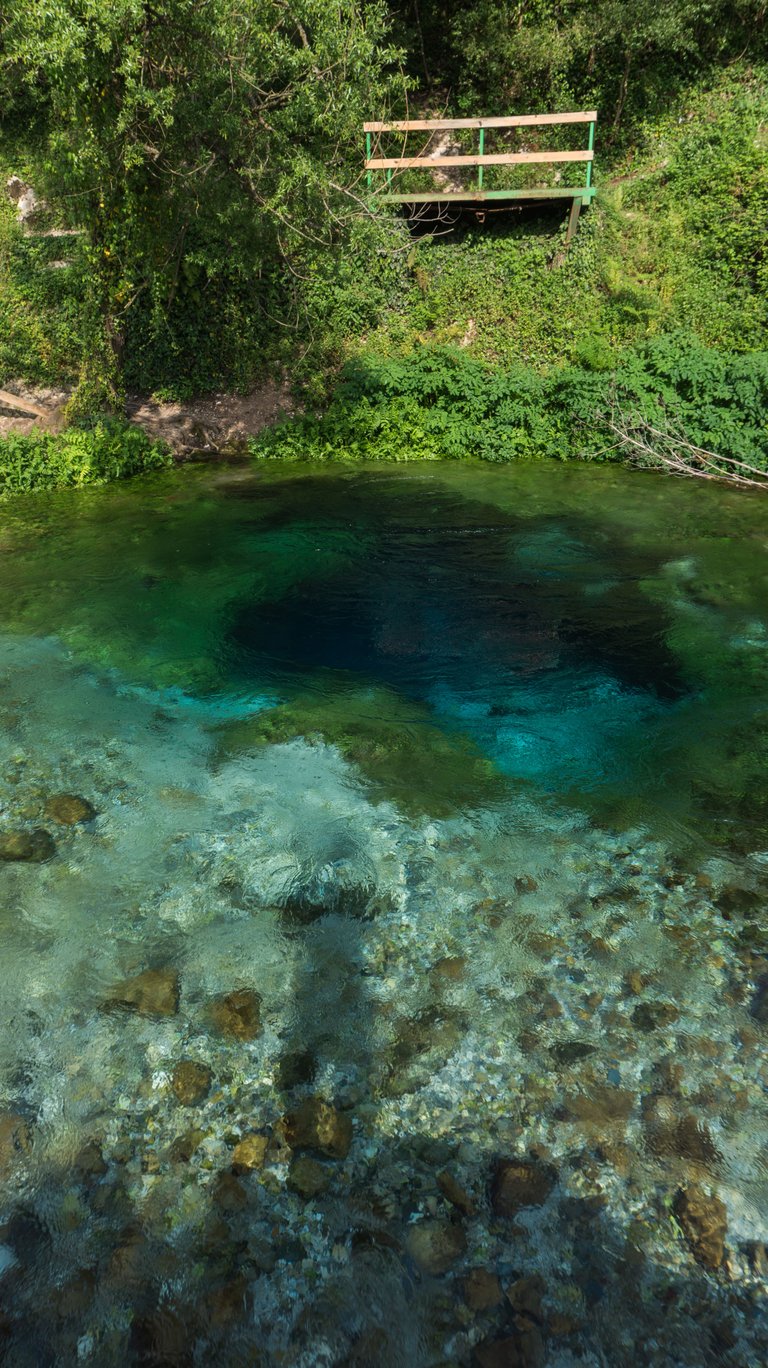
It sounds like it hasn't yet been fully explored, but divers have been down at least 50 meters into the cave.
How to get there
This post wouldn't be complete unless I provided some tips for getting there. If you find yourself in Saranda (and you absolutely should!), you may not encounter too many English-speakers, but you should be able to find somebody in town (young people are usually a good bet) who can translate to a taxi driver that you want a round trip ride to the Blue Eye.
This will cost somewhere between €30-40 for the approximately half hour ride, 1-2 hours at the site while the driver waits, and the return trip. Payment will most likely not be asked for until you have returned. You may be able to negotiate a bit lower if the city isn't crowded with tourists when you are there, but keeping the history you just learned in mind, don't be afraid to spend your money while there! After all, your driver likely has lived through the economic depression of the Communist regime followed by several years of unrest - I think you can afford a nice tip for a good job done at least, assuming you get there and back safely :)
It's a windy road of varying quality to get there, so keep that in mind if you get motion sickness. If you want to see even more, there are also some notable ruins at a place called Butrint. You can agree with the driver to see both of them. I'm not sure of the normal cost as we were short on time and had just been in Greece at the Acropolis, so we elected the nature experience instead.
Bold prediction
Albania's rather tragic history may have left the country years behind most of the rest of Europe, but I feel that Albania's day is coming. I predict it will rise in popularity as a tourist destination as it continues to develop over the next couple of decades.
As it is now in April 2017, we were able to sit on the waterfront, at one of the nicest restaurants in town, soaking up the warm sun rays, the clear water of the Mediterranean Sea a literal stone's throw in front of us, drinking Albanian beers (Elbar) at €1.43 a pop. And that's expensive by current Albanian standards I'd venture to say. I could literally sit and drink all day for the price of a single beer at a bar here in Norway.
I hope to revisit in 10, 20 years and see how much that has changed. I'll bet you an Elbar it's a good deal more than that.
In the meantime, do yourself a favor and get yourself to Albania!
Adventure Every Day is a travel & exploration channel started in 2016. In addition to the Steemit blog, I post short films of my adventures to the Adventure Every Day YouTube channel. Please follow and subscribe if you enjoy the content!

P.S. Comments welcome! I'm particularly interested to hear if people found this post entertaining and useful. For example, was the history interesting and educational or an added subtraction? Thanks!
Awesome article! I'm happy to see people go to Albania and are informed of their history!
As far as your question if people were able to visit from the west at time of the communism.. As far as i know it was possible and it did happen, just not very much because of the strict rules and the fact that people just felt it was unsafe.
Upvoted + followed you ! :D
Thanks for your comment and your insight about how the situation was for visitors during that time.
I hope to post a video from my trips to Albania sometime in the near future as well :)
Resteemed for being interesting and I seldom do resteems.
Wow! Thank you so much my friend!! I really appreciate it.
I love history told in a non-boring way.
Me too! That was my goal here, so Im glad you found the format worked okay. It certainly took a bit of work to dig up the info but i learned a lot, so glad at least 1 person enjoyed it :)
I hope to do more similar posts as I have the chance to visit other "lesser known" countries. Ill check out your blog as well when i have time a little later.
See you around!
What a wonderful post, I agree the Azure Blue Waters are splendid.
Thanks so much for reading @sunscape!!
spent 6 week in Albania in 1994 hard to explain!
Wow @woodenart I have to hear more! What was the mood like in the country at the time? Excitement that the Communist regime was gone, or was there already a sense of dissatisfacion with the new government?
It seemed every home had tv but only had electricity a few hours a week. Buses had no seat some did not even have floors. Animal drawn carts and bike shared the road with the some of the nicest "hot" cars I ever saw.
Very interesting, thanks for sharing. Buses with so floors does not sound like a very good concept haha. I can confirm that, at least in the more remote areas, there is still quite a bit of use of animal drawn carts, especially with donkeys where I was on my first trip. Also did not have any electricity issues but wouldn't be surprised to hear if those types of issues still exist in some parts of the country.
Amazing! It makes me want to jump in.
I know right! There were a couple brave folks who jumped off the overlook. I took my shoes off and walked in, so I can at least confirm for you that it was freezing cold. Haha!
Brilliant work dear friend @adventureevryday congratulations on the beautiful captures, thank you very much for the good story
Thanks so much for reading and commenting my friend!
Great post.
My main interrest are photography , so i will follow you because of your photos.
Love the photos "Example of bunkers" and the first from the blue eye.
Thanks @waldfee! I'm quite an amateur photographer but love getting outside to take some photos. See you around on here :)
Awesome article Thank you for sharing it :)
Thank you for reading it!